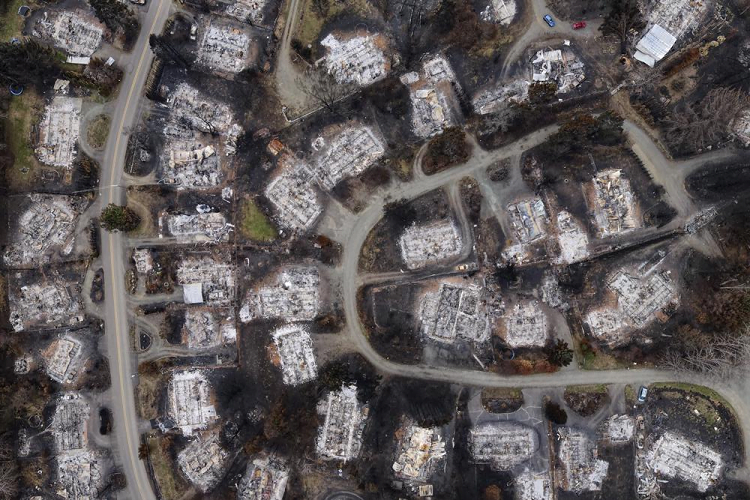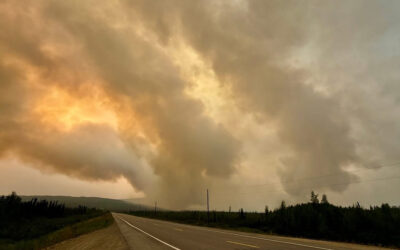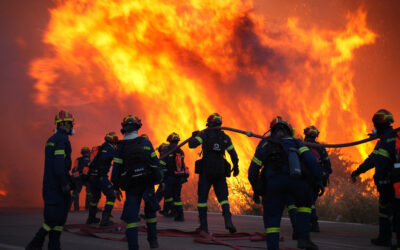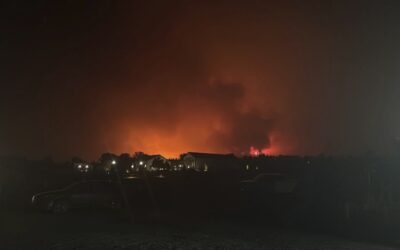Oregon is now starting fire season amid some of the worst conditions in memory

In this aerial photo provided by Matt Brandt Photography, are homes burned by wildfire near Pony Trail Lane in Otis, Ore., on Sept. 21, 2020. Oregon’s unprecedented wildfire season last fall burned 4,000 homes and more than 1 million acres in areas that aren’t normally associated with wildfire. Experts say the 2020 wildfire season in Oregon was a taste of what lies ahead as climate change makes blazes more likely and more destructive even in wetter, cooler climates like the Pacific Northwest. (Matt Brandt Photography via AP)
By GILLIAN FLACCUS Associated Press
OTIS, Ore. (AP) — Wildfire smoke was thick when Tye and Melynda Small went to bed on Labor Day, but they weren’t too concerned. After all, they live in a part of Oregon where ferns grow from tree trunks and rainfall averages more than six feet (1.8 meters) a year.
But just after midnight, a neighbor awakened them as towering flames, pushed by gusting winds, bore down. The Smalls and their four children fled, leaving behind 26 pet chickens, two goldfish and a duck named Gerard as wind whipped the blaze into a fiery tornado and trees exploded around them.
When it was over, they were left homeless by a peril they had never imagined. Only two houses on their street in Otis survived a fire they expected to be tamped out long before it reached their door less than six miles (9.6 kilometers) from the Pacific.
“Nobody ever thought that on the Oregon coast we would have a fire like this. Here … it rains. It rains three-quarters of the year,” Melynda Small said. “It was one of the scariest things I’ve ever gone through.”
The fire that leveled the rural community of 3,500 people was part of an Oregon wildfire season last fall that destroyed more than 4,000 homes, killed nine people and raged through 1.1 million acres (445,154 hectares). Almost all the damage occurred over a hellish 72 hours that stretched firefighters to their breaking point.
Pushed by unusually strong winds, fires ripped through temperate rainforest just a few minutes’ drive from the ocean, crept to within 30 miles (48 kilometers) of downtown Portland, leveled thousands of homes and businesses along Interstate 5 and wiped out communities that cater to outdoors enthusiasts.
It was a wake-up call for the Pacific Northwest as climate change brings destructive blazes that feel more like California’s annual fire siege to wet places and urban landscapes once believed insulated from them. And as the U.S. West enters yet another year of drought, Oregon is now starting fire season amid some of the worst conditions in memory.
The state weathered its driest April in 80 years, and in the normally wet months of March and April, it had the lightest rainfall since 1924. Several fires started this week, triggering evacuations and road closures as temperatures soared.
Marc Brooks, who founded Cascade Relief Team to help last fall’s fire victims statewide, said by this April his group had been put on alert four times for wildfires at a time when “we should be getting snow, not drought.”
The warming climate means snow on Oregon’s famous peaks melts earlier, leaving soil and vegetation parched by late summer even if it does rain, said Erica Fleishman, director of the Oregon Climate Change Research Institute at Oregon State University.
Last fall’s blazes were driven by “extremely rare” powerful, sustained winds, and in combination with the arid conditions, a major wildfire was almost inevitable, she said. “If we had a spark — and any time we have people, we have a spark — there was a high likelihood that a fire would ignite.”
Fire on the Oregon coast isn’t without precedent. A series of blazes starting in the 1930s scorched 355,000 acres (143,663 hectares) in what’s known as the Tillamook Burn. In 1936, a wind-driven fire killed 10 people in the seaside town of Bandon.
But what happened last fall across western Oregon was extreme, said Larry O’Neill, Oregon’s state climatologist.
The Cascade Mountains run north-south and separate the notoriously rainy part of the state to the west and the drier climate to the east, where fires usually burn in less populated areas. Last year multiple blazes raged in the western Cascades where “you think of it being a rainforest with ferns” and closer to population centers, O’Neill said.
“I thought we still had a generation or so to get our ducks in a row to prepare for this, and these last couple fire seasons here have been a huge wake-up call that we are experiencing it now,” said O’Neill.
One fire in southwest Oregon obliterated thousands of homes in two towns along Interstate 5, and was unique for Oregon because it was fueled by houses, gas stations and fast-food restaurants — not forest, said Doug Grafe, head of the Oregon Department of Forestry.
“To lose the number of communities that we did was eye-opening,” he said. “That’s new ground for Oregon, but California was the canary in the coal mine.”
Last fall, that new reality reshaped the Smalls’ life — and the lives of hundreds of other Oregon residents — in just a few hours. The Echo Mountain Fire burned nearly 300 homes and displaced about 1,000 people.
Like many of their neighbors, the Smalls were underinsured and did not have wildfire coverage for their white house with green trim. They bounced around for weeks — an emergency evacuation site, camping by a stream and staying with relatives in Washington state.
An insurance payout of $50,000 was not enough to buy a manufactured home big enough for their family. Eight months after the fire, the money goes to keep their kids in a single room at a local Comfort Inn, while the parents sleep in a borrowed trailer outside.
The family had two rooms paid for by the state, but when wildfire survivors were asked to move to a different motel, the Smalls decided to stay and pay their own way rather than uproot their family again. They said they didn’t qualify for federal disaster assistance and that the pandemic cost Tye Small his job as a gas station attendant.
“Our 5-year-old, she had a really hard time. She kept saying …‘We need to go home. We need to feed the fish. We need to feed the chickens,’” Melynda Small said, gazing at her home’s ruins. “And so we actually had to bring her here to show her that we didn’t need to come feed the fish or feed the chickens.”
Unsure of the future, the couple has filled days helping neighbors clear their properties and serving as cheerleaders for the devastated community while their children — ages 18, 15, 9 and 5 — do school work at the motel.
Every time a new manufactured home is delivered to a fire survivor, Melynda Small is there in her “Otis Strong” sweatshirt, beaming with excitement and taking photos for a community Facebook page. By her last tally, there are 38 new manufactured homes and six “stick builds” in progress.
This spring, pink tulips she had planted in front of her house, under the kitchen window, bloomed in the ashes.
“It’s actually a lot of progress. It seems like it’s been really fast, but it’s been almost a year,” she said. “I think the time is just going by faster for me because I’ve been so busy doing all of the other things, keeping my mind busy, my hands busy.”
___
AP Science Writer Seth Borenstein contributed to this report from Kensington, Maryland.
___
The Associated Press Health and Science Department receives support from the Howard Hughes Medical Institute’s Department of Science Education. The AP is solely responsible for all content.
___
Follow Gillian Flaccus on Twitter at http://www.twitter.com/gflaccus
All contents © copyright 2021 The Associated Press. All rights reserved.




